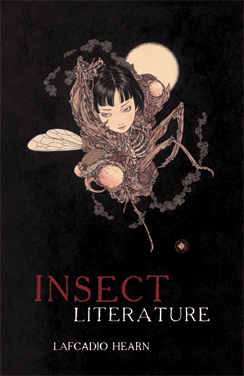What’s the best way to tell area residents about plans for a new asylum shelter nearby?
The government should tell communities directly about plans for new asylum shelters, some activists and politicians say.
This eclectic bundle of essays, translations, myths and folktales, is all tied together by one unlikely theme.

Lafcadio Hearn’s Insect Literature offers a thrilling insight into the sumptuous weirdness of the insect world and the cultural and symbolic significance heretofore wholly overlooked, certainly by myself and, I suspect, by today’s Western world in general.
“The insect world is altogether a world of goblins and fairies: creatures with organs of which we cannot discover the use, and senses of which we cannot imagine the nature;—creatures with myriads of eyes, or with eyes moving about at the end of trunks or horns;—creatures with ears in their legs and bellies, or with brains in their waists!
“. . . the more that we learn about these miraculous creatures, the more difficult does it become for us to write poetically about their lives, or about their possible ways of thinking or feeling. Probably no mortal man will ever be able to imagine how insects think or feel or hear or even see. Not only are their senses totally different from those of animals, but they appear to have a variety of special senses about which we cannot know anything at all.”
Born in the Greek Island of Lefkado in 1850, Hearn was raised in Ireland and England. As an adult he travelled widely and his ferocious interest in other cultures adds wonderful breadth and scope to Insect Literature.
First published posthumously in Tokyo in 1921, this eclectic bundle of essays, translations, myths and folktales touches on sources as disparate as Talmudic literature, ancient Buddhist tales, and the unpublished “Grasshopper” poem of Tennyson.
Swan River Press has done a wonderful job of this edition: a beautifully designed hardback dotted through with delicate, apt and carefully sourced line drawings and calligraphy.
Hearn developed an interest in insects while working in the United States, and later Japan. Despite some attitudes that seem out-of-date by today’s standards, he was by no means typical of his time. After enjoying some success as a sensationalist journalist in Cincinnati, he was fired from the Cincinnati Daily Enquirer for violating Ohio’s miscegenation laws, a decision the paper tried to reverse as Hearn’s success grew.
His accounts of the Bucktown and Levee neighbourhoods of Cincinnati are among the few depictions we have of black life in a border city during the post-Civil War period. Hearn went on to become a successful editor, major translator of the short stories of Maupassant and even a wood-cut cartoonist before leaving the US for Japan.
While he may be accused of exoticising other cultures, his accounts of populations and practices underrepresented in the West are starkly original for a man of his place and time. He became naturalised in Japan, even converting to Buddhism in later life.

Reading Insect Literature was refreshing and invigorating; so many new interests were piqued, so many theories were sparked. Almost every page holds some titbit of insect life or insect symbolism that I had either overlooked or never come across.
The writing is, granted, unwittingly comical at times: “Only feminine malice can explain the ingenious capacity for torment caused by the mosquito,” he pontificates; and in the sections on Japan there are lengthy passages full of quaint orientalism; “—you cannot imagine the real charm of queerness and prettiness, the wonderful blending of grotesquery and beauty, to be found in the life of the common people.”
But, if anything, these relics of their time only add to the charm. Hearn’s enthusiasm is utterly contagious.
The first half of the collection is dedicated to Japanese and Chinese culture. Holding scant knowledge of the cultures, I could only find them fascinating.
His writings on romantic poetry and “French ditties” are perhaps the least interesting of the collection. They don’t have much to offer in critical terms, but his focus on the historical significance of insects and spiders, and his comparison between their representations in Eastern and Western culture, is a whole fascinating subject, and it is genuinely wonderful to have poems collected under this theme. Hearn’s philosophical musings are nothing more than whimsy, but he is certainly inspiring.
Sandwiched in between the fact-lists, folktales and myths are some charming and moving anecdotes about his own insect-keeping. Although the academic rigour of Hearn’s research strikes me as somewhat suspect, any more thorough a study would have resulted in a much longer, denser and less readable book.
All in all, this volume is genuinely fascinating and an absolute joy to read. Though well worth sourcing, it is an unlikely choice for a general reader, which makes its high-quality republication a small kind of miracle.
There is a dull sort of disappointment in getting what you want from a book. How much more exciting to discover something you didn’t know to look for?
Insect Literature, by Lafcadio Hearn (Swan River Press, October 2015)